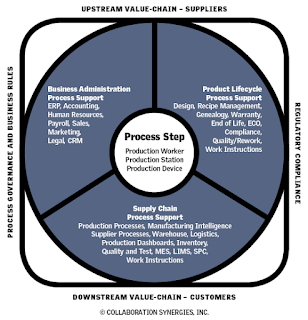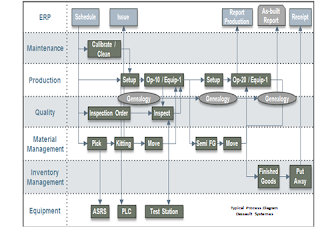Business processes in today’s typical manufacturing environment is, at
best, full of information gaps. Within the major enterprise level systems
such as ERP or PLM most processes are based or focused on departmental issues
which means the processes are not cross-functional.
Production Process Management (PPM) is the missing link that supports
Smart Manufacturing. PPM is a specialized version of Business Process
Management (BPM) that describes the concept of applying process design and
management tools to the areas of manufacturing plant and supply chain
activities within and across the extended enterprise.
HOW MOST PROCESSES WORK TODAY
Business processes, especially those that connect to the plant floor,
operate based on the horizontal and sequential needs to produce products. But,
it has been difficult to include all necessary data management into one fully
integrated package.
One example is in a Human Resources application within ERP.
Employment history, wage administration, performance reviews, etc. are all
covered in fine detail. However, when the MES needs to confirm training
qualifications at a work station, the manual integration or “sneaker net” must
take over. The other option is to have the IT department build a significant,
custom application.
Another example is the retrieval of a pallet of material to be used at
the assembly line. There are different steps that can be taken to
complete this task, especially when working with small to global-sized
enterprises. The good news is that many of these steps are common.
Overall steps: Trigger—someone or some system (Kanban, production
schedule, replenishment alarm, etc.) recognizes the current work station
stockpile has reached the replenishment level and requests additional
supply.
Steps in a low volume environment:
|
Steps in a larger, higher velocity or
multiple SKU facility this may require a number of steps including:
|
The system could be as simple as
viewing a work station and noticing replenishment is necessary.
|
|
At this point the replenishment process example is not even half
developed and we can see the many information gaps and potential for
errors. The steps in this example will require multiple electronic
systems (ERP, MES, etc.) and manual steps to contribute to the process
execution and with each step there is greater potential for easy and costly
mistakes.
THE GOAL OF SMART MANUFACTURING
A key objective of Smart Manufacturing is addressing the need to
eliminate process gaps including manual steps like searching for information
across various electronic systems. This is a formidable task to say the
least.
The problem, as we all know, is the physical weaving of digital process
data through each of the electronic or manual processes across the extended
enterprise. The historical record of attempting to do this with systems
integration software coding techniques has caused much more grief than
satisfaction. So, other than
wishing for a better world, how can Smart Manufacturing be different?
 ●
Standards—There
is significant effort being made to develop and promote standard methods,
interfaces and technologies to exchange information between software applications.
●
Standards—There
is significant effort being made to develop and promote standard methods,
interfaces and technologies to exchange information between software applications.
●
New
applications—new applications are being developed that address specific
operations niches such as inventory movement or energy management or
environmental management concerns.
●
Process management—a
rapidly growing vendor market segment is providing new tools to assist in
planning, modeling, inventorying and managing your business and production
processes.
●
Process
execution—the past few years have seen substantial growth in the use of workflow
and business process management software systems. These approaches will
greatly enhance information management techniques on the plant floor.
WORKFLOW AND PROCESS MANAGEMENT
The newer concepts of Workflow and Process Management focus on
supporting the business process rather than on the features and functions of
siloed applications. A workflow consists of an orchestrated and
repeatable pattern of business activity enabled by the systematic organization
of resources into processes that transform materials, provide services, or
process information. These methodologies retrieve and provide data
elements from their source as necessary to accomplish work.
One example is the retrieval and display of work instructions to an
assembly station. This action may require information from many sources
but the key perspectives here are the delivery to the workstation, focus on the
business process, and focus on what is necessary to support each step in that
process. Workflow information management techniques were originally developed
in the nineties and have enjoyed extensive application success in a wide
variety of business applications including the plant floor.
HOW PPM HELPS SMART
MANUFACTURING
Business Process
Management is an approach that is based on workflow ideas but has a
substantially broader toolset. BPM has enjoyed extensive success since
the mid 2000s particularly in high volume processes found in administrative
industries such as insurance and finance.
As mentioned at
the start of this article, Production Process Management (PPM) is a specialized
version of BPM describing the concept of applying process design and management
tools to the areas of manufacturing plant and supply chain activities within
and across the extended enterprise.
Processes are
designed to follow chronological steps of how you want to run the business by
connecting and supporting predefined, sequenced events with the correct
information in a role-based form for the intended user. A process may be fully
electronic, fully or partially manual, or a hybrid of the two. One key
requirement is that the process is specific to, and configurable to fit, the
given business requirement and provides an easy path for revision and
improvement.
The Smart
Manufacturing Leadership Coalition (SMLC) and other sources support this
process-centric approach to information management and have provided some
examples of what might be possible.
1. Separate data from the application and invert the
historical manufacturing paradigm by bringing the data to the application
instead of the application to the data.
2. Provide actionable data, trust and visibility across
the supply/value chain.
3. Manage orchestration of standardized decision workflows
based on structured adaption and autonomy.
4. Deploy applications that can share data, data that can
share applications and applications that can connect to applications to achieve
horizontal enterprise views and actions.
5. Build applications that cross different time
constraints and seams, including the supply/value chain.
6. Provide applications that do not lose control of state.
7. An enterprise level platform to manage and support
applications/processes that can be company-wide standards yet specific to the
existing local plant information system infrastructure.
8. Build information tools that can differentiate company
performance and provide a competitive advantage through operational and
information management techniques.
9. Easy to understand applications/processes that can
evolve to solve changing business needs.
10. Information management concepts that allow operational
processes to be company owned intellectual property.
11.
An information management infrastructure that is easier
to manage, less costly and more supportive of users.
12. Computer driven processes that can be supported by
manual involvement, fully automatic or a combination of either.
 The concept of using a process-centric approach to support production
is a key element of Smart Manufacturing. It creates a completely new
understanding of enterprise-wide information management -- an area fraught with
high IT cost, wide information gaps and much buyer angst.
The concept of using a process-centric approach to support production
is a key element of Smart Manufacturing. It creates a completely new
understanding of enterprise-wide information management -- an area fraught with
high IT cost, wide information gaps and much buyer angst.
The new process view gives manufacturers a wider horizon to think
strategically using information to build and maintain a competitive advantage
wholly based on how they want to run the business. The view is top down and
strategic. Response and global maneuverability are the issues, not data
collection or equipment efficiency. The executed process is the unit of
automation. How processes are defined and managed is the tactical stroke that
supports the enterprise strategy.
Manufacturing is best managed at the process level. Processes
span end-to-end across functions, departments, sites and capabilities, are
highly dynamic and must easily be updated to ensure manufacturing systems
remain agile to business changes.
For example, ERP started with End-to-End processes focused solely on
the fundamentals of the business. This must not only be extended across the
value chain in a horizontal dimension, but also taken deeper to drill down to
the specific details that support each step of production activity with
appropriate role based information.
The future perspective will be much less based on the functions within
an application, and much more on how information from any resource can best
support the user’s business and production processes. To paraphrase an
old political adage from a few years ago—“it’s all about the process.”

No comments:
Post a Comment